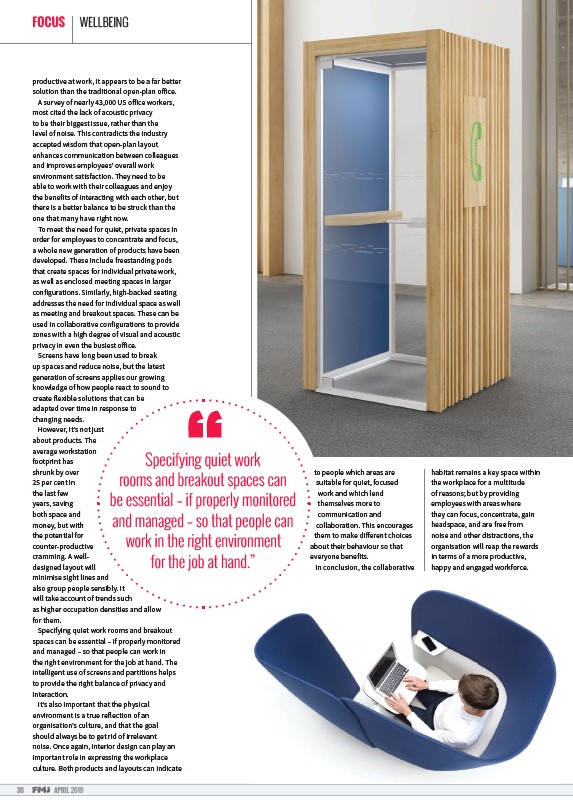
FOCUS WELLBEING
productive at work, it appears to be a far better
solution than the traditional open-plan o ice.
A survey of nearly 43,000 US o ice workers,
most cited the lack of acoustic privacy
to be their biggest issue, rather than the
level of noise. This contradicts the industry
accepted wisdom that open-plan layout
enhances communication between colleagues
and improves employees’ overall work
environment satisfaction. They need to be
able to work with their colleagues and enjoy
the benefits of interacting with each other, but
there is a better balance to be struck than the
one that many have right now.
To meet the need for quiet, private spaces in
order for employees to concentrate and focus,
a whole new generation of products have been
developed. These include freestanding pods
that create spaces for individual private work,
as well as enclosed meeting spaces in larger
configurations. Similarly, high-backed seating
addresses the need for individual space as well
as meeting and breakout spaces. These can be
used in collaborative configurations to provide
zones with a high degree of visual and acoustic
privacy in even the busiest o ice.
Screens have long been used to break
up spaces and reduce noise, but the latest
generation of screens applies our growing
knowledge of how people react to sound to
create flexible solutions that can be
adapted over time in response to
changing needs.
However, it’s not just
about products. The
average workstation
footprint has
shrunk by over
25 per cent in
the last few
years, saving
both space and
money, but with
the potential for
counter-productive
cramming. A welldesigned
layout will
minimise sight lines and
also group people sensibly. It
will take account of trends such
as higher occupation densities and allow
for them.
Specifying quiet work rooms and breakout
spaces can be essential – if properly monitored
and managed – so that people can work in
the right environment for the job at hand. The
intelligent use of screens and partitions helps
to provide the right balance of privacy and
interaction.
It’s also important that the physical
environment is a true reflection of an
organisation’s culture, and that the goal
should always be to get rid of irrelevant
noise. Once again, interior design can play an
important role in expressing the workplace
culture. Both products and layouts can indicate
38 APRIL 2019
habitat remains a key space within
the workplace for a multitude
of reasons; but by providing
employees with areas where
they can focus, concentrate, gain
headspace, and are free from
noise and other distractions, the
organisation will reap the rewards
in terms of a more productive,
happy and engaged workforce.
to people which areas are
suitable for quiet, focused
work and which lend
themselves more to
communication and
collaboration. This encourages
them to make di erent choices
about their behaviour so that
everyone benefits.
In conclusion, the collaborative
Specifying quiet work
rooms and breakout spaces can
be essential – if properly monitored
and managed – so that people can
work in the right environment
for the job at hand.”